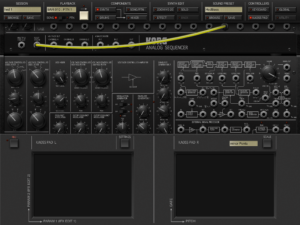Somewhat surprising to me, after finally getting a new iPad to replace an “ancient too soon” iPad 2, I found myself using the first iOS synth app I ever purchased more than the rest of my iOS music app collection – old or new. Simply put, the Korg iMS-20 simply serves my current musical needs more than the others.
Granted, I still haven’t picked up the Moog Model 15 app. That one is coming soon. I’ve played a bit with Audulus 3; enjoy Korg’s ODYSSEYi, and wrote new loops on Rebirth and the iPolysix. Still, the iMS-20 resonates with me. So, here’s another love letter.
Fewer Options lead to More Inspiration?
There’s not even a published iMS-20 review here at TabMuse, as I had already moved on to newer apps by the time this website started. I still loved creating drum and bass loops with it, followed by additional composition and overdubs. The title track from Church of Hed’s Electric Sepulcher album and the cut Transaxiom, from the Autumn Shrine EP, both feature the iMS-20.

Great sound and a classic skeuomorphic interface make it easy to dive right in and create beats. The limitations of the iMS-20 – one monophonic synth and a drum machine – are compatible with a desire to use the app for beatmaking, knowing the overdubbing of other tracks using hardware and software synths comes next.
Despite creating a few beats in Korg Gadget, that app’s larger sound seems more appropriate for building a full production within the app, which isn’t normally the way I work. Thus, I don’t have anything released with a Gadget beat. Maybe someday, as it remains a great app.
By the way, it is possible to get additional melodic content out of the iMS-20 by using a tonal sound in one of the drum machine tracks and programming a melody with the sequencer. Is this yet another case of limitations leading to inspiration?
I Dream of Virtual Wires
As a virtual simulation of the classic Korg MS-20, the iMS-20 features a patch bay, making it possible to modify the synth sound using virtual cables. Sequencer patching is necessary for composing beats in odd time-signatures as well. Creating polyrhythmic patterns in this manner is a breeze, and something I want to explore further on upcoming projects.
Two Kaoss Pads enable the real-time manipulation of the included effects, synth parameters, and even sequencer melodies and patterns. Many times, instead of rendering the audio of an iMS-20 project and loading into the Pro Tools, I’ll just do a live performance into the DAW using outboard effects along with the virtual Kaoss Pads. This creates something warmer and more sonically interesting as a basis for further composition and overdubs.
One of the best beats the Muse recently delivered to the studio involves the iMS-20, so she obviously prefers it as well. Expect to hear the track that grew around this beat on a future release, along with others sure to come. Ultimately, when I wake up in the morning to compose a beat, while still showing love for the street, I reach for the Korg iMS-20.



